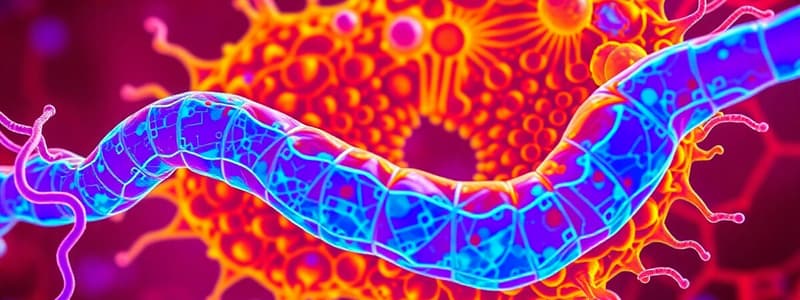Podcast
Questions and Answers
Which of the following proteins involved in cotranslational translocation of proteins into the ER membrane is NOT a GTP-hydrolyzing protein?
Which of the following proteins involved in cotranslational translocation of proteins into the ER membrane is NOT a GTP-hydrolyzing protein?
- elongation factors in ribosome-mediated mRNA translation
- P54 subunit of SRP
- a subunit of the SRP receptor
- Sec61 translocon (correct)
Protein insertion into the mammalian ER membrane is typically:
Protein insertion into the mammalian ER membrane is typically:
- post-translational.
- pretranslational.
- cotranslational. (correct)
- quasitranslational.
Post-translational translocation of some secretory proteins in yeast is powered by:
Post-translational translocation of some secretory proteins in yeast is powered by:
- ATP hydrolysis by BiP. (correct)
- cAMP hydrolysis by cAMP phosphodiesterase.
- phospholipid hydrolysis by phospholipase C.
- GTP hydrolysis EF-Tu.
In a cell-free protein synthesis system utilizing microsomes from fragmented ER, under which condition could you determine if the new protein was imported into the microsome?
In a cell-free protein synthesis system utilizing microsomes from fragmented ER, under which condition could you determine if the new protein was imported into the microsome?
Which of the following is true about ER import?
Which of the following is true about ER import?
Type I membrane proteins have all of the following properties, except:
Type I membrane proteins have all of the following properties, except:
GPI-anchoring serves a special function, especially in polarized epithelial cells, because this modification serves to target proteins to the:
GPI-anchoring serves a special function, especially in polarized epithelial cells, because this modification serves to target proteins to the:
Glycosylation, a post-translational modification of proteins, occurs in the:
Glycosylation, a post-translational modification of proteins, occurs in the:
All the following proteins interact with exposed amino acids during protein folding in the ER, except:
All the following proteins interact with exposed amino acids during protein folding in the ER, except:
Unassembled or misfolded proteins in the RER can be damaging to the physiology of a cell and therefore are transported to the cytosol where they are degraded. This transport process is referred to as:
Unassembled or misfolded proteins in the RER can be damaging to the physiology of a cell and therefore are transported to the cytosol where they are degraded. This transport process is referred to as:
A transmembrane receptor that functions at the cell membrane has an exoplasmic N-terminal sequence, a signal-anchor sequence, and a stop-transfer-anchor sequence. This protein was first inserted into the membrane where?
A transmembrane receptor that functions at the cell membrane has an exoplasmic N-terminal sequence, a signal-anchor sequence, and a stop-transfer-anchor sequence. This protein was first inserted into the membrane where?
Sorting of proteins to mitochondria and chloroplasts is:
Sorting of proteins to mitochondria and chloroplasts is:
Tom/Tim and Toc/Tic protein complexes are involved in:
Tom/Tim and Toc/Tic protein complexes are involved in:
Protein sequences for targeting to mitochondria or chloroplasts are located at:
Protein sequences for targeting to mitochondria or chloroplasts are located at:
Protein import into the mitochondrial matrix is supported by energy input from:
Protein import into the mitochondrial matrix is supported by energy input from:
A polypeptide chain contains an amphipathic helix, with arginine and lysine residues on one side and hydrophobic residues on the other. It will likely enter:
A polypeptide chain contains an amphipathic helix, with arginine and lysine residues on one side and hydrophobic residues on the other. It will likely enter:
In a cell that lacks cytosolic Hsc70:
In a cell that lacks cytosolic Hsc70:
Which of the following components of mitochondrial import are NOT required for a sequence containing a matrix-targeting sequence and an intermembrane-space-targeting sequence?
Which of the following components of mitochondrial import are NOT required for a sequence containing a matrix-targeting sequence and an intermembrane-space-targeting sequence?
Many peroxisomal matrix proteins are imported as:
Many peroxisomal matrix proteins are imported as:
The nuclear pore complex allows for:
The nuclear pore complex allows for:
PTS1- and PTS2-bearing matrix proteins are targeted to:
PTS1- and PTS2-bearing matrix proteins are targeted to:
Unlike mitochondria and chloroplasts, peroxisomes can arise _____ from precursor membranes, as well as by division of preexisting organelles.
Unlike mitochondria and chloroplasts, peroxisomes can arise _____ from precursor membranes, as well as by division of preexisting organelles.
Many peroxisomal matrix proteins are imported as:
Many peroxisomal matrix proteins are imported as:
During the import of proteins into the nucleus, the alpha importin subunit binds directly to:
During the import of proteins into the nucleus, the alpha importin subunit binds directly to:
Which type of RNA participates in nuclear export of mRNA?
Which type of RNA participates in nuclear export of mRNA?
Which of the following is present in the nuclear export sequence of PKI (an inhibitor of protein kinase A)?
Which of the following is present in the nuclear export sequence of PKI (an inhibitor of protein kinase A)?
Transport of unspliced HIV mRNA from the nucleus to the cytoplasm of host cells is promoted by a virus-encoded protein named:
Transport of unspliced HIV mRNA from the nucleus to the cytoplasm of host cells is promoted by a virus-encoded protein named:
The nuclear pore complex (NPC) contains_____ structures that form a gel-like matrix that allow small molecules to diffuse through, but require larger proteins to enter via importin or other nuclear chaperones.
The nuclear pore complex (NPC) contains_____ structures that form a gel-like matrix that allow small molecules to diffuse through, but require larger proteins to enter via importin or other nuclear chaperones.
During the process of nuclear import, a GEF works in the:
During the process of nuclear import, a GEF works in the:
The topology of membrane proteins can often be predicted by computer programs that identify ______ topogenic segments.
The topology of membrane proteins can often be predicted by computer programs that identify ______ topogenic segments.
Flashcards
Cotranslational translocation
Cotranslational translocation
Protein insertion into the ER membrane while still being synthesized by ribosomes.
Post-translational translocation
Post-translational translocation
Protein insertion into the ER membrane after its complete synthesis.
Signal sequence (N-terminal)
Signal sequence (N-terminal)
Short amino acid sequence targeting a protein to the ER. Hydrophobic core precedes positively charged amino acids.
Type I membrane protein
Type I membrane protein
Signup and view all the flashcards
GPI anchor
GPI anchor
Signup and view all the flashcards
Hydrophobic topogenic segment
Hydrophobic topogenic segment
Signup and view all the flashcards
ER quality control
ER quality control
Signup and view all the flashcards
ERAD
ERAD
Signup and view all the flashcards
Mitochondrial protein import
Mitochondrial protein import
Signup and view all the flashcards
Nuclear pore complex import/export
Nuclear pore complex import/export
Signup and view all the flashcards
Peroxisomal protein import
Peroxisomal protein import
Signup and view all the flashcards
Study Notes
Moving Proteins Into Membranes and Organelles
-
Section 13.1 Protein Translocation into the ER Membrane
- The SRP receptor and elongation factors are GTP-hydrolyzing proteins involved in cotranslational translocation
- Protein insertion into the mammalian ER membrane is typically cotranslational
- Post-translational translocation in yeast is powered by ATP hydrolysis by BiP
- Proteins synthesized in the cytosol, and lacking targeting information, will diffuse throughout the cytosol
-
Section 13.1 Signal Sequences for ER targeting
- N-terminal signal sequences (16-30 amino acids) target proteins to the ER.
- These sequences have a hydrophobic core (6-12 amino acids) and one or more positively charged amino acids preceding it.
-
Section 13.1 ER Import
- Signal sequences are necessary for import to the ER.
- Signal Recognition Particles (SRPs) are needed during co-translational import.
-
Section 13.2 GPI-Anchoring and Protein Topology
- GPI-anchoring targets proteins to the plasma membrane
- In multipass proteins, signal-anchor and stop-transfer sequences alternate, directing insertion into the ER membrane.
- The topology of membrane proteins can be predicted by computer programs that recognize different sequences.
-
Section 13.2 Quality Control of Protein Folding
- Misfolded proteins are transported to the cytosol for degradation
- This is considered protein quality control in the ER
-
Section 13.3 Glycosylation in the ER
- Glycosylation, a post-translational modification, primarily occurs in the Golgi
-
Section 13.3 Protein Folding within the ER
- ER lumen proteins interact with BiP, calnexin, PDI, and prolyl isomerase to fold properly
-
Section 13.4 Protein Sorting to Mitochondria and Chloroplasts
- Protein sorting to mitochondria and chloroplasts is predominantly post-translational
-
Section 13.4 Protein Import into Thylakoids
- Several pathways are involved in importing proteins into thylakoids.
-
Section 13.4 Protein Import into Mitochondria
- Protein import into the mitochondrial matrix is driven by ATP hydrolysis by chaperone proteins and the proton-motive force.
- Protein import into mitochondria is post-translational.
-
Section 13.5 Peroxisomal Protein Import
- Peroxisomal matrix proteins are imported as folded proteins
-
Section 13.5 Peroxisome Formation
- Peroxisomes can arise from either preexisting organelles or de novo
-
Section 13.6 Protein Import into the Nucleus
- Importin proteins bind directly to basic nuclear localization signals in cargo proteins.
- Ran-GTP is involved in nuclear export
-
Section 13.6 Nuclear Export
- Ran-GTP and exportin-1 facilitate nuclear export of proteins.
Studying That Suits You
Use AI to generate personalized quizzes and flashcards to suit your learning preferences.




